Can Cats Eat Steak? Find Out Now
As we know, Steak is a human favorite food famous for its succulent taste, tender texture, and versatility in preparation, but “Can Cats Eat Steak?”, this question may those cat owners have in minds who share their food with cats, if you are one of them, do not worry, because
In this informative blog, we are going to talk about cats and steak and their impacts ( risks and benefits ) on cats. As well as we will also discuss other relevant questions to cats and steak in this blog. So let’s get started.
Nutritional Contents Of Steak.
| Nutrients | Amount in 100 grams |
| Protein | 25 g |
| Total Fat | 19 g |
| Cholesterol | 78 mg |
| Sodium | 58 mg |
| Potassium | 279 mg |
| Total Carbohydrate | 0 g |
| Iron | 2.4 mg |
| Vitamin B-6 | 0.5 mg |
| Calcium | 12 mg |
| Magnesium | 23 mg |
| Vitamin D | 6 IU |
| Vitamin A | 25 IU |
| Calories | 271 |
Can Cats Eat Steak?
Yes, cats can eat steak but in moderation. Steak can be a tasty treat for your feline friend, providing a source of protein. However, it’s important to remember that cats are obligate carnivores, so meat should only complement their balanced diet. Always ensure the steak is cooked thoroughly and free from seasonings that may harm your cat’s health.
Is Steak Good For Cats?
No, steak is not necessarily good for cats. While it can be a tasty treat, cats require a balanced diet that includes specific nutrients found in cat food. Steak alone may not provide all the essential nutrients cats need to thrive. Moderation is key, and it’s important to consult with a veterinarian before introducing steak or any human food into your cat’s diet.
What Are The Health Benefits Of Feeding My Cat Steak?
The benefits of feeding your cat steak:
1: Enhanced Protein Intake:
Protein is crucial for cats as they are obligate carnivores, meaning they require a diet primarily composed of meat. Steak provides a high-quality source of protein, which is essential for maintaining muscle mass, supporting organ function, and promoting overall health.
2: Palatability:
The rich flavor and aroma of steak can make it very appealing to cats, especially those who may be picky eaters or have poor appetites. Offering steak as an occasional treat can make mealtimes more enjoyable for your cat and ensure they get the nutrients they need.
3: Variety in Diet:
Introducing steak to your cat’s diet occasionally adds variety, preventing monotony and possible malnutrition. While commercial cat food provides balanced nutrition, offering a variety of foods such as steak can stimulate your cat’s interest and ensure they get a variety of nutrients.
4: Source of Energy:
Steak contains both protein and fat, providing your cat with a source of energy to support their daily activities and metabolic processes. The energy derived from steak can help keep your cat active, and playful, and maintain a healthy weight.
5: Bonding Opportunity:
Sharing a small portion of steak with your cat creates a positive bond between you and your pet. It provides an opportunity to spend quality time together, fosters a strong bond, and strengthens the trust between you and your beloved partner.
6: Coat and Skin Health:
The fats in steak, such as omega-3 and omega-6 fatty acids, contribute to a healthy coat and skin for your cat. These essential nutrients help maintain skin elasticity, reduce inflammation, and promote a shiny, glossy coat.
7: Dental Health:
Chewing small pieces of steak can provide mechanical action that helps remove plaque and tartar from your cat’s teeth. Although it is not a substitute for regular dental care, offering steak as a treat can complement dental hygiene efforts and promote better oral health.
8: Appetite Stimulation:
The appealing smell and taste of steak can stimulate your cat’s appetite, especially if she’s temporarily losing interest in her usual food. Offering steak as a treat can rekindle their enthusiasm for food and ensure they consume adequate amounts of nutrients.
9: Mental Stimulation:
Introducing new textures and flavors through steak can provide mental stimulation for your cat. Cats are curious creatures, and offering them a variety of food can engage their senses, and keep their minds active and alert.
10: Social Interaction:
Feeding your cat steak can be a shared experience, strengthening the bond between you and your pet. Whether it’s preparing a steak together or enjoying it together, sharing a meal fosters a sense of camaraderie and mutual affection.
Is Steak Bad For Cats?

No, steak is not inherently bad for cats. However, it can lead to potential risks if not fed properly. Steak should be served in moderation and prepared without any spices or additives that could harm your cat’s health. Additionally, it should not replace a balanced cat food in their diet, as it may lack essential nutrients for feline health. It is advisable to consult a veterinarian before introducing steak into your cat’s diet to ensure that their nutritional needs are met safely.
Potential Health Risks Of Steak To Cats Health
The potential health risks of feeding your cat steak:
1: Digestive Upset:
Steak can be rich and fatty, which can cause gastrointestinal upset in some cats. An abundance of steak can overwhelm a cat’s digestive system, resulting in symptoms such as vomiting, diarrhea, or abdominal pain.
2: Pancreatitis:
Pancreatitis is inflammation of the pancreas, often triggered by high-fat foods like steak. Cats with pancreatitis may experience symptoms such as vomiting, lethargy, and loss of appetite. It is important to monitor your cat’s fat intake and avoid feeding them high-fat foods such as steak to prevent pancreatitis.
3: Obesity:
Feeding cats steak in large quantities or too often can lead to weight gain and obesity. Obesity in cats increases the risk of various health problems, including diabetes, arthritis, and heart disease. Serving steak as an occasional treat and portion control is critical to preventing obesity in cats.
4: Nutritional Imbalance:
Although steak is a good source of protein, it lacks essential nutrients found in balanced cat food, such as vitamins, minerals, and taurine. Feeding steak as a staple diet or replacing cat food with steak can lead to nutritional imbalances and deficiencies in cats. It is essential to feed cats a balanced diet that is adapted to fit their unique nutritional needs.
5: Bone Fragments:
Steak may contain small pieces of bone that can pose a choking hazard or cause intestinal obstruction if eaten by cats. Especially cooked bones can break easily and cause serious damage to a cat’s digestive tract. It is safer to remove any bones from the steak before feeding your cat to avoid choking or injuries.
6: Allergic Reactions:
Some cats may be allergic to steak ingredients, such as certain proteins or additives. Allergic reactions may manifest as hives, skin rashes, gastrointestinal upset, or respiratory symptoms. If you suspect your cat is allergic to steak or any other food, consult a veterinarian to determine an appropriate diet.
7: Bacterial Contamination:
Raw or undercooked steak may contain some harmful bacteria such as E. coli and salmonella which can cause food poisoning in cats. Bacterial contamination in steak poses health risks not only to cats but also to humans who handle or consume it. It is important to handle raw meat safely and cook it thoroughly to kill any harmful bacteria before feeding it to your cat. Additionally, always wash your hands and food preparation surfaces after handling raw meat to prevent the spread of bacteria.
How Much Steak Can I Feed My Cat?
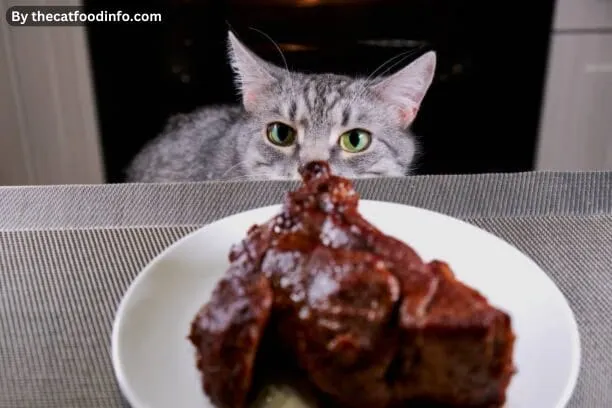
The amount of steak you can feed your cat depends on a variety of factors, including your cat’s size, age, and overall health. As a general rule, steak should be served as an occasional treat rather than the main part of their diet. A small piece of cooked, unseasoned steak once or twice a week is usually safe for most cats. However, it’s important to monitor your cat’s weight and digestive response to make sure she’s tolerating the steak well.
How Should I Feed My Cat Steak?
Steps you must follow before feeding steak to your cat.
1: Preparation:
Before feeding your cat steak, it’s important to prepare it properly. Remove any bones, fat, or seasoning from the steak, as these can pose choking hazards or cause digestive problems in cats. Cook the steak thoroughly to kill any harmful bacteria and make it easier for your cat to digest.
2: Portion Size:
Consider your cat’s size and nutritional needs when determining steak portion sizes. A small piece of cooked, unseasoned steak is usually sufficient as an occasional treat. Avoid feeding your cat large portions of steak, as this can cause weight gain or indigestion.
3: Frequency:
Steak should be offered to your cat as an occasional treat rather than a regular part of their diet. Limit steak to once or twice a week to prevent nutritional imbalances and potential health problems. Add variety to your cat’s diet by rotating different protein sources and treats.
4: Feeding Method:
When feeding your cat steak, consider the best way to avoid overeating. You can serve small pieces of steak as a standalone treat, mix it with their regular meal, or use it as a topping. Monitor your cat while she eats to make sure she is chewing properly and not eating too quickly.
5: Observation:
Monitor your cat’s response to eating steak, including any changes in behavior, appetite, or digestive health. If you notice any adverse reactions such as vomiting, diarrhea, or lethargy, stop eating the steak and consult your veterinarian for guidance.
6: Veterinary Consultation:
Before adding steak or any new food to your cat’s diet, it is recommended that you consult your veterinarian. They can provide personalized recommendations based on your cat’s specific needs and nutritional needs, ensuring that their health and well-being are a priority.
Steak Allergic Reaction Symptoms In Cats
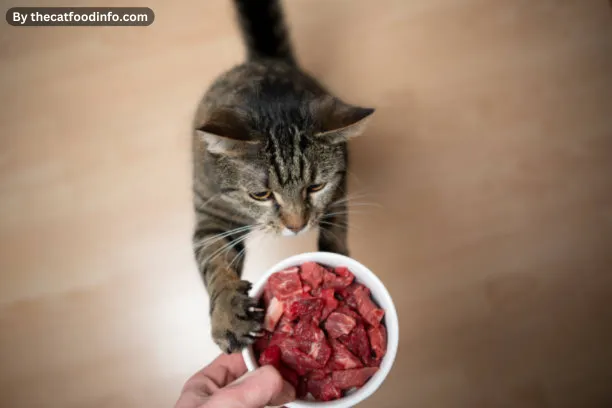
It is important to monitor your cat closely for any signs of an allergic reaction after feeding steak. If you suspect your cat is experiencing an allergic reaction, consult a veterinarian immediately for diagnosis and treatment.
1: Itching and Scratching:
One of the most common symptoms of an allergic reaction to steak in cats is itching and scratching. Your cat may overgroom, scratch, or rub against an object to relieve the itch.
2: Skin Rashes or Redness:
An allergic reaction to steak can cause itchy or reddened skin in the affected areas. You may notice itchy skin, red spots, or signs of inflammation on your cat’s body, especially around the face, neck, or belly.
3: Swelling or Hives:
In some cases, cats may experience swelling or hives as part of an allergic reaction to steak. Swelling may occur around the face, eyes, lips, or throat, and hives may appear as raised, red patches on the skin.
4: Gastrointestinal Upset:
An allergic reaction to steak can also manifest as gastrointestinal upset in cats. Symptoms may include vomiting, diarrhea, abdominal pain, or loss of appetite. These digestive problems can range from mild to severe.
5: Respiratory Symptoms:
In rare cases, cats may exhibit respiratory symptoms as part of an allergic reaction to steak. This may include sneezing, coughing, wheezing, or difficulty breathing. Respiratory symptoms may indicate a more severe allergic reaction and require immediate veterinary attention.
6: Lethargy or Weakness:
An allergic reaction can make your cat feel lethargic or weak. They may appear tired, have reduced energy levels, or feel less interested in their usual activities. Lethargy may be a sign of a systemic allergic reaction and should be taken seriously.
7: Facial Swelling or Difficulty Breathing:
In severe cases, cats may experience swelling of the face, especially around the eyes, lips or throat. This can lead to difficulty breathing, which is a medical emergency requiring immediate veterinary care. If you notice facial swelling or any signs of respiratory distress, seek veterinary help immediately.
8: Anaphylaxis:
Anaphylaxis is a severe, life-threatening allergic reaction that can occur quickly after consuming steak. Symptoms may include a sudden drop in blood pressure, collapse, seizures, or fainting. Anaphylaxis requires immediate emergency veterinary treatment to stabilize your cat’s condition.
Can I Feed My Cat Raw Steak?
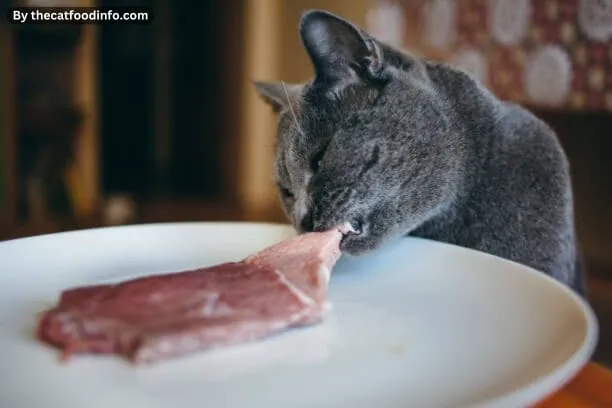
It is not recommended to feed your cat raw steak. Raw steak can contain harmful bacteria like salmonella or E. coli that can make your cat sick. Cooking the steak thoroughly kills these bacteria, making your cat’s food safer. It is always best to cook meat before feeding it to your cat to avoid foodborne illness.
Conclusion
It’s okay for cats to enjoy steak as an occasional treat, but caution is important. Steak can provide extra protein, taste great, and add variety to their diet, but it shouldn’t replace their regular cat food. Overdosing on steak can cause stomach problems, pancreatitis, weight gain, and nutritional imbalances. Always eat steak in moderation, make sure it’s boneless, and properly cooked, and check with your doctor first. Prioritize your cat’s health over adding steak, and remember, a little goes a long way in strengthening your bond with your furry friend.
FAQs
Can Cats Eat Steak Everyday In Small Amounts?
No, it is not recommended. While cats may enjoy the occasional steak, feeding it every day, even in small amounts, can cause health problems due to unbalanced nutrition and possible digestive issues.
Can I Give My Cat Cooked Steak?
Yes, cooked steak is safe for cats to eat occasionally, but make sure it’s thoroughly cooked, boneless, and served in moderation to avoid potential health problems.
What Meat Should Cats Not Eat?
Avoid feeding cats raw or spoiled meat, as well as meats with bones, seasoning, or additives. Stick to lean, cooked meats like chicken, turkey, or beef without any extra ingredients to keep your cat safe and healthy.
Is Steak Fat Bad For Cats?
Excessive fat in steak can lead to digestive upset and obesity in cats if fed in large quantities. It’s best to offer lean cuts of cooked steak in moderation to avoid potential health issues.
Do Cats Like To Eat Steak?
Many cats enjoy the taste and smell of steak, finding it tasty and appealing as an occasional treat. However, individual preferences can vary, so it’s important to observe your cat’s reaction when serving steak.
Can Other Pets Eat Steak Safely?
Some other pets, such as dogs, can safely enjoy steak as an occasional treat, but it’s important to consider their individual dietary needs and consult a veterinarian. Avoid feeding steak to pets with digestive problems or pets with specific dietary restrictions.

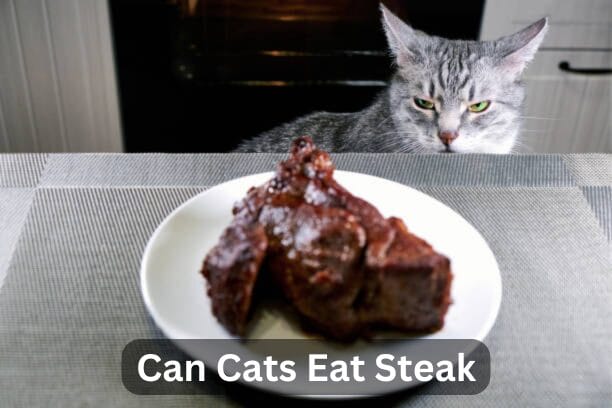

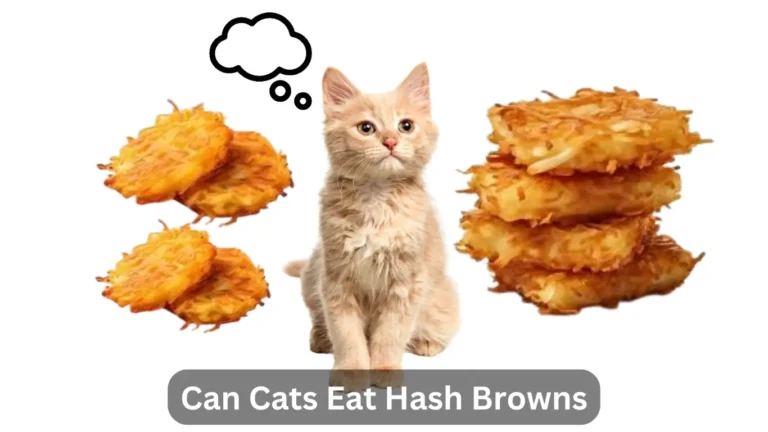
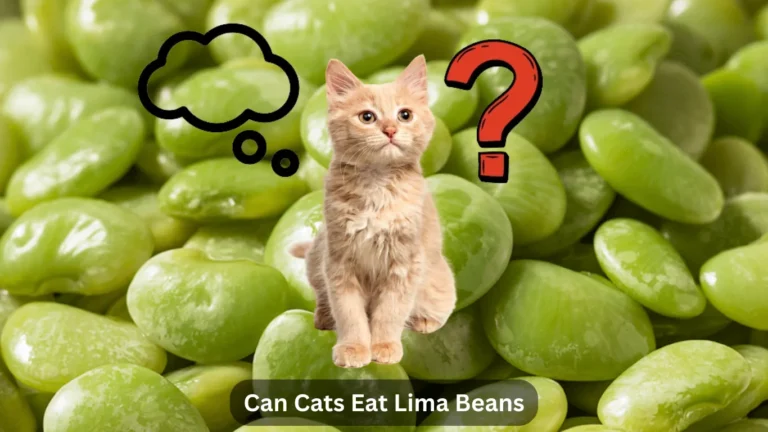
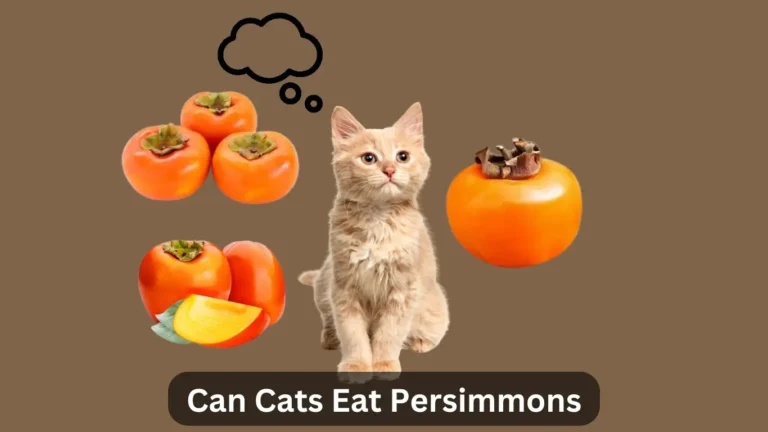
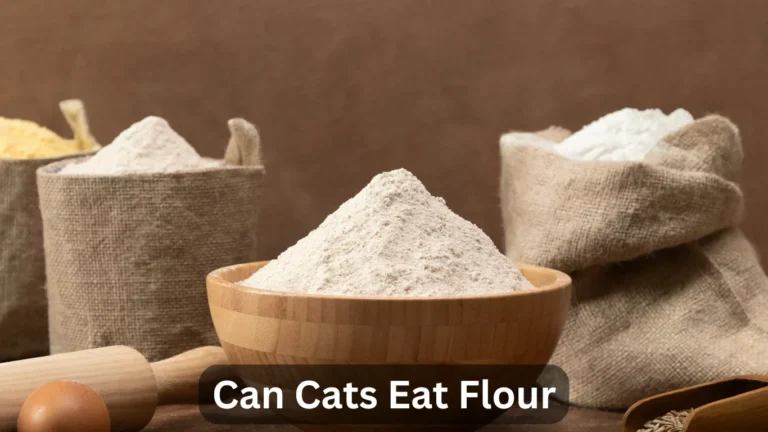
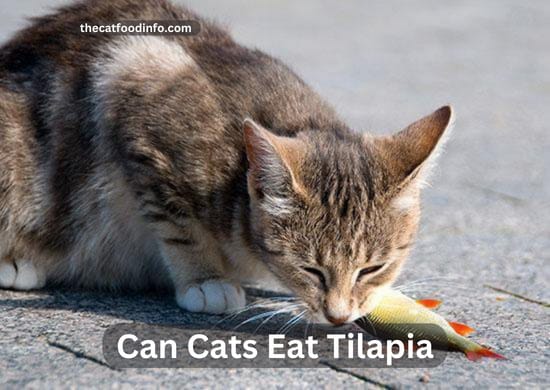
One Comment